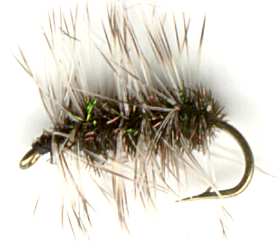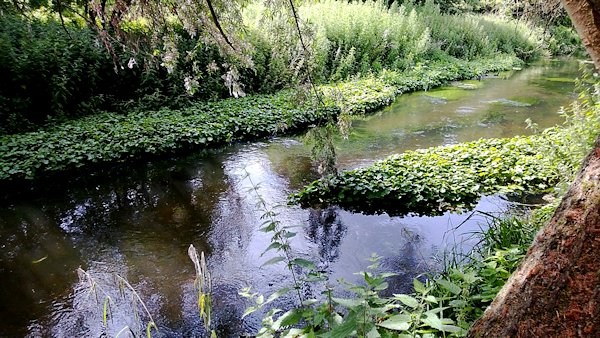The Black Griffith's Gnat Dry Fly
Midges or gnats are the staple diet of most trout. These tiny insects are found on most rivers, lakes and streams. This popular American fly pattern is used to imitate egg-laying adult midges and emerging midges.

DRY FLY PATTERNS. Hook size 16 20 24 - $US each
George Griffith, one of the founding fathers of the American Trout Unlimited, created one of the most important midge dressings. The Griffith's Gnat is simple, no more than a peacock herl or dubbed body, overwound with grizzly hackle. The beauty of the fly is how it floats half in and half out of the surface film representing something stuck, trying to emerge from its shuck. After having had some coverage in the British and European fly fishing press it has now successfully crossed the Atlantic. These flies are very small having a black body and whitish wings. The small black midge (polypedilum nubeculosus) and similar species are common and widespread.
Hatches are normally during the evening and often prolific. In the late summer you may come across early morning hatches if the temperature is right. The larvae and pupae of these insects can be found in countless numbers in stagnant and stillwater. You will find them in rainwater butts as well as the margins of lakes, ponds and ox-bow sections of rivers. Although called a gnat it is a great all round dry fly, effective on lakes, reservoirs, rivers and streams. It can suggest all sorts of insects that are trapped in the surface film. It is also a useful representation of chrionomid midges in a mating ball floating down the river. The body is made of peacock herl with a grizzle cock hackle wound around its length. To help it float and keep weight down to the minimum there is no ribbing.
HOW TO CATCH A FISH - READ THE RIVER
Where do you think trout are lurking in this photograph? When you get to the river bank take
some time to study the layout. Do not just start casting and hope for the best.
Time taken "reading the river" will bring dividends ten fold. The flow of the
river is from the top right corner down to the bottom left. The current is
blocked by the clump of weeds jutting out into the center of the river. This has
the effect of slowing down the speed of the river downstream behind this mass of
foliage and speeding it up where the river narrows. The water behind the weed
clump is just the sort of place favored by hungry lurking trout. They can stay
in the relative slack water and watch their food flow past their nose in the
faster flowing section of the river water. When they see something tasty they
attack. Your tactic will be to cast a fly like the Griffiths Gnat or a
subsurface nymph fly pattern upstream of the weed clump and let you fly drift
past the tip of the weed clump and be prepared for a take.

If it is a hot day trout can also be found hiding from the sun and birds of prey on the far river bank in the area of shade just under the aquatic weeds that line the bankside. They stay close to the edge and only venture out when they spot something interesting to eat. The same tactic of casting up stream and letting your fishing fly drift past this location should work as well. If you look after a stretch of river then clumps of healthy aquatic plants like these shown in the photograph below are desirable to ensure the health of your fish population. They provide shelter for young fish who live between the steams and new shoots as well as ideal lurking resting areas for adult fish who are on the look out for their next insect meal.
CUSTOMER'S COMMENT
I fish the Pequest River in New Jersey. It is the stretch that flows from the spillway that leaves the Pequest hatchery. One of the top trout catching early season flies are your black Griffiths Gnat in hook sizes 18-20-22 as they imitate the small black midges. Tight Lines, Fred Ungaretta NJ,USA

Fly Fishing books

